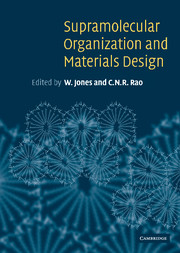Book contents
- Frontmatter
- Contents
- List of contributors
- Preface
- 1 Assembly and mineralization processes in biomineralization: strategies for forming biological composite materials
- 2 Mesoscale materials synthesis and beyond
- 3 Towards the rational design of zeolite frameworks
- 4 Mesoscale self-assembly: the assembly of micron-and millimeter-sized objects using capillary forces
- 5 Design of amphiphiles for the modulation of catalytic, membranous and gelation properties
- 6 Nanofabrication by the surface sol-gel process and molecular imprinting
- 7 The hierarchy of open-framework structures in metal phosphates and oxalates
- 8 Mesoscale self-assembly of metal nanocrystals into ordered arrays and giant clusters
- 9 Layered double hydroxides as templates for the formation of supramolecular structures
- 10 Molecular machines
- 11 Some aspects of supramolecular design of organic materials
- 12 Controlling crystal architecure in molecular solids: the supramolecular approach
- Index
4 - Mesoscale self-assembly: the assembly of micron-and millimeter-sized objects using capillary forces
Published online by Cambridge University Press: 18 December 2009
- Frontmatter
- Contents
- List of contributors
- Preface
- 1 Assembly and mineralization processes in biomineralization: strategies for forming biological composite materials
- 2 Mesoscale materials synthesis and beyond
- 3 Towards the rational design of zeolite frameworks
- 4 Mesoscale self-assembly: the assembly of micron-and millimeter-sized objects using capillary forces
- 5 Design of amphiphiles for the modulation of catalytic, membranous and gelation properties
- 6 Nanofabrication by the surface sol-gel process and molecular imprinting
- 7 The hierarchy of open-framework structures in metal phosphates and oxalates
- 8 Mesoscale self-assembly of metal nanocrystals into ordered arrays and giant clusters
- 9 Layered double hydroxides as templates for the formation of supramolecular structures
- 10 Molecular machines
- 11 Some aspects of supramolecular design of organic materials
- 12 Controlling crystal architecure in molecular solids: the supramolecular approach
- Index
Summary
This chapter describes experimental and conceptual issues in mesoscale selfassembly (MESA), using examples from our work in the assembly of millimeter-and micron(micrometer)-sized polyhedral objects using capillary forces. In MESA, objects (from nm to mm in size) self-assemble into ordered arrays through noncovalent forces. Three systems that use capillary forces in MESA are described: these involve the assembly of objects into two-dimensional arrays at the perfluorodecalin/H2O interface, into three-dimensional arrays at curved liquid/liquid interfaces, and into three-dimensional arrays from a suspension in water. The capillary interactions between objects can be viewed as a type of ‘bond’ that is analogous to chemical bonds that act between atoms and molecules.
Introduction
Scope and objectives of the review
Mesoscale self-assembly (MESA) is the self-assembly of objects ranging in size from 3 nm to 10 mm, and interacting through a variety of forces (capillary, magnetic, electrostatic, and light forces). Examples of MESA include the aggregation of gold colloids coated with DNA-terminated self-assembled monolayers (SAMs) using the formation of DNA/DNA duplexes (nanometerscale self-assembly) [ref. 1]; the crystallization of polystyrene spheres using capillary or electrostatic forces (micron-scale self-assembly) [refs. 2–4]; and the formation of ordered structures from polyhedral objects of polydimethylsiloxane using lateral capillary forces (millimeter-scale self-assembly) [refs. 5, 6]. This chapter describes the area of MESA, with a focus on our work using capillary forces to assemble small objects into ordered arrays or aggregates [refs. 5–15].
- Type
- Chapter
- Information
- Supramolecular Organization and Materials Design , pp. 103 - 145Publisher: Cambridge University PressPrint publication year: 2001
- 4
- Cited by



